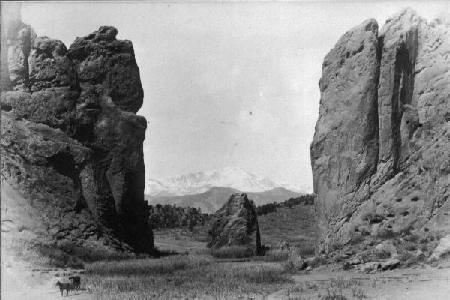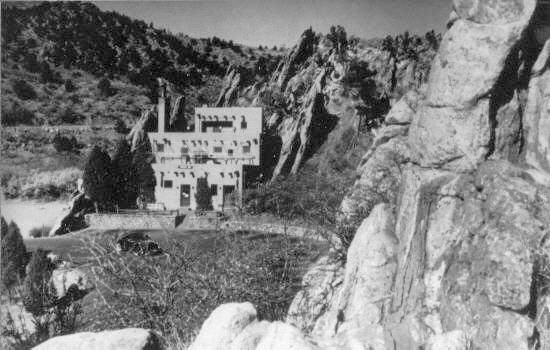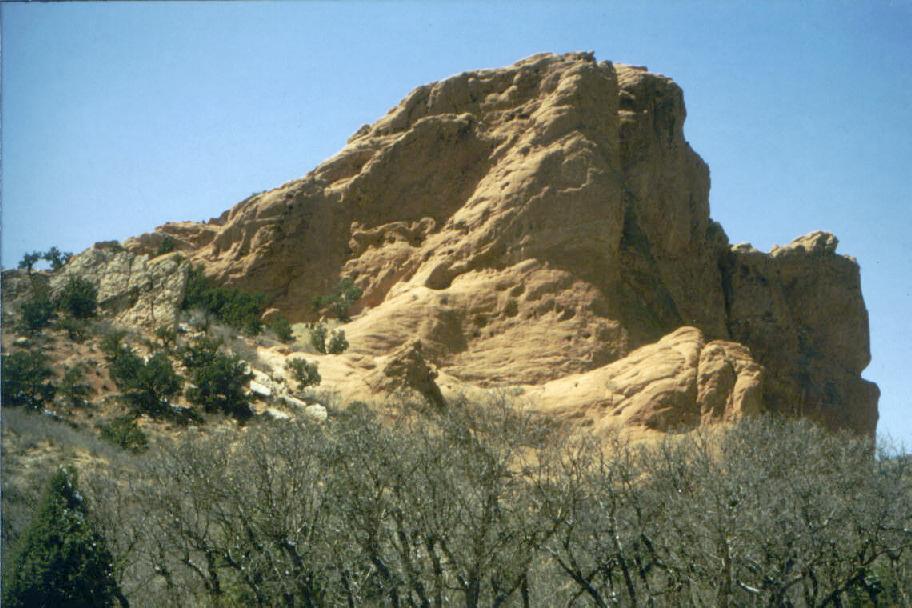
Early visitors to the Garden of the Gods often referred to the Gateway Rocks as the "Beautiful Gate." When James Meline rode though in 1866 he thought that the two walls of stone only served to heighten the illusion of a grand portal. William M. Thayer described this gate in 1890 as "not a gate of human workmanship. There is an air of the artificial about it, because the massive portals seem to have been carved; but the workmanship is all divine. The plan, too, is divine. The pillars of the gate, on either side, composed of red sandstone, are three hundred and eighty feet high, - too high for any one but the Great Architect to think of rearing."
Owing, perhaps, to its position at the eastern entrance to the Garden, the area surrounding the Gateway Rocks was a choice site for many of the early structures. As early as 1871 George C. Anderson found an abandoned dwelling there:
"some fifty or sixty feet past the Gateway and to the right, some enterprising fellow has built a house about twelve by fourteen feet in size, the floor was laid, the windows and door frame were cased, the sash had not been put in, nor the door hung. The smooth woodwork within was covered with the names of visitors from all parts of the world, written with pencil, and to perpetuate the name of the Ohio Soldiers Colony we did likewise."Thirteen years later a promoter named Billy Bryan built a resort on the same spot. The resort was the subject of a glowing report in the 30 June 1883 issue of the Colorado Springs Weekly Gazette. "Billy now has one of the most attractive little places in the country," the report read, "and should meet with liberal patronage." To further enchance his resort, Billy hired a local resident named Penton Hardwick to chisel steps to the top of nearby North Gateway Rock. The stairway was completed in time for a grand opening celeration on the 4th of July. Penton later claimed that he was never paid for his work.
In 1915 an Indian-style pueblo, called the Hidden Inn, was built near the site of the two earlier sructures. This pueblo was built at a cost of $7,500 by the park commission in cooperation with the city of Colorado Springs. It featured fireplaces copied from early Native American design, reproduction of scenes from the Pikes Peak region on the windows, and lighting from bulbs hidden inside Indian wedding bowls. The red plaster which covered the exterior was chosen to exactly duplicate the color of the surrounding sandstone rocks.
This gutter was first written of by a young man named Calvin Perry Clark. Calvin was a gold seeker during the great Pikes Peak Gold Rush. He visited the red rocks during the summer of 1859. "I started off in a rain storm," he wrote, "which wet me to the skin to see some verry curios looking stone" After helping a fellow gold seeker down off North Gateway, Calvin paused for a moment to admire the great rock:
Like its neighbor to the north, South Gateway is home to those unfailing harbingers of spring, the white-throated Swifts. The Swifts always arrive in the Garden of the Gods just before the spring equinox. They come in two flocks, a day apart - first a small advance guard, then the main group of several hundred. The birds are famous for never landing on the ground. They build their nests high in the inaccesible crevices of the Gateway Rocks, and catch all their food on the wing. When summer turns to fall, they abandon the Garden to fly south in one large flock.
1- Touring Kansas and Colorado in 1871: the Journal of George C. Anderson. Kansas Historical Quarterly, Vol. XXII, No.4, Winter 1956.
2- Two Diaries, introduced by Malcolm G. Wyer. Denver Public Library, 1962.
3- Two Thousand Miles on Horseback by James F. Meline. Albuquerque: Horn and Wallace.
4- Marvels of the New Westby William M. Thayer. Norwich: The Henry Hill Publishing Company, 1890.
The Hidden Inn served visitors as a gift shop and snack bar for eighty years. Though still sructurally sound, it was torn down in 1997 as part of a Master Plan recommendation to remove all manmade structures from the central Garden area.

North Gateway has many natural and man-made features. High atop the rock is a natural sculpture known as the Kissing Camels. On the north end is the 300-foot Tower of Babel, characterized by a fault-line which partially separates it from the main rock. On the south end is the Perkins Tablet, a memorial commemorating the 1909 gift of the Garden of the Gods to the cty of Colorado Springs. On the backside - near the remains of Billy Bryan's stone stairway - is an area favored for technical rock climbling. And on the frontside of North Gateway is a natural gutter that fills with water during rainstorms."this rock is some six or seven hundred feet high and as is the custom with the rock here upon their sides or edges. and on the south end thare is a slide some 300 feet which runs down a streem of water when it rains about as big as a 6 inch stove pipe and has a decent about 70 degrees down and smothe as a rain troth as it had dug a hole about 3 f deep in the bottom, and when raining the water rushing into this hole forms a verry pretty water spout which is increased by quantity, but as the rain had ceased the running had nearly also."

South Gateway features a myriad of formatins, including the Lion Head, Old Rocking Chair, the Tomb, and the Weeping Indian. The Weeping Indian is a fifty-foot facial figure on the backside of the rock, more than a hundred feet off the ground. It is best viewed in late afternoon.
SOURCES: